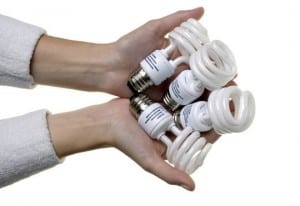We have all heard about the benefits of the new CFL energy efficient light bulbs. It saves you money on electricity and you don’t have to replace them as often, how nice! It all sounds good until you realize these CFL bulbs contain mercury which poses a significant risks in many areas of your health.
Because these lights contain mercury, a huge issue is what happens if you break one. We were shocked to find out that there are actually several very important steps that need to be taken if that occurs, however none of these steps are even mentioned on the packaging of these bulbs.
If a bulb breaks, most of us would reach of the vacuum for clean up the mess, however that is actually the worst thing you can do because that can spread the mercury. Believe it or not, if you break a bulb, the very first thing you need to do is evacuate the room for 10 minutes, open windows/doors and shut off central AC/heat if you have one.
This is imperative because at the time the bulb breaks, the concentration of mercury vapor (one of the most toxic forms) in the air is hundreds of times greater than what is considered safe. This is especially important for children as the recommended limit for them is just 0.2 mcg/m3 and if exposed, a child will receive eight thousand times the limit.
Then, carefully collect all the broken pieces of glass and use a damp cloth/paper towel to wipe up any remaining powder and seal everything (broken pieces and cleaning cloth) in a plastic bag. Do not place any fragments in your regular indoor garbage can but rather bring the sealed plastic bag directly outside. After the cleanup is completed, leave the windows open and AC/Heat off and avoid occupying that room for the next several hours.
Additionally, a new study shows that CFL bulbs also emit high levels of ultraviolet radiation. UVA and UVC rays emitted are strong enough to actually burn the skin and experts say this radiation could initiate cell death and cause melanoma, one of the deadliest forms of skin cancer.
Manufacturers that make these bulbs claim they have installed a special protective layer to prevent this but when researchers testing this, they found small cracks all over this layer in every bulb. These cracks are what allowed dangerous UV rays to get through. It was found that healthy skin cells exposed to CFLs showed an increase in free radicals (bad things that damage cells and can lead to cancer) and a decrease in their ability to build collagen (needed for healthy skin).
Manufacturers also claim that CFLs don’t produce a large amount of UV radiation, no more than being outside in the sun. As with most products though, when tested in isolation, they do not produce the same effect as in real life. Because these bulbs contain mercury vapor, it combines with the electric current and therefore the UV rays emitted are increased greatly. Ceiling bulbs are farther away and probably do not cause as much threat but bulbs used for reading and in table lamps which are much closer to you can certainly pose a problem.
CFL bulbs contains other cancer-causing chemicals such as naphthalene and styrene which are activated when the bulbs are turned on.
Using less energy is amazing for the environment but we can’t forgets that the mercury is still in the bulb when you are done using it and that can contaminate our soil and water supply when they end up in landfills.
You may want to consider buying LED lights which are just as energy efficient and are completely mercury-free.

